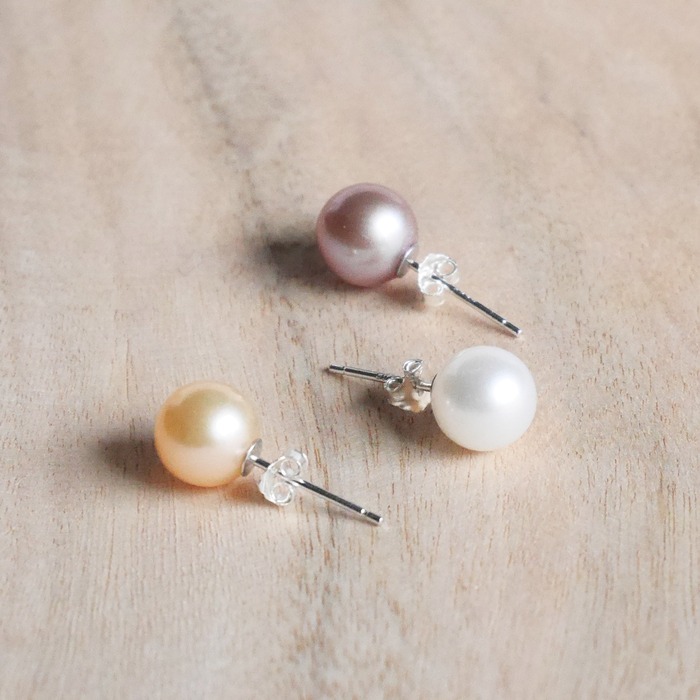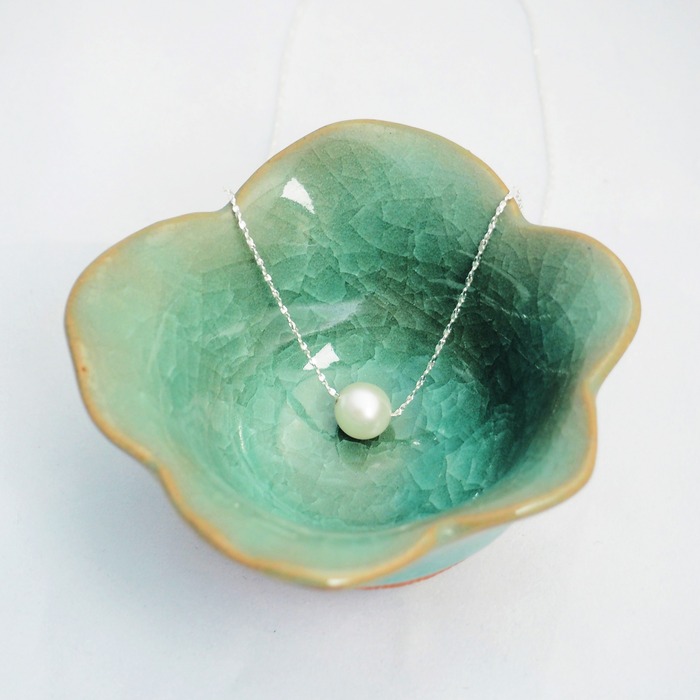Many guests often ask us whether they are getting real pearls or imitation pearls. They also ask us what exactly are the differences between the two. Here we’ll answer these questions by showing you the common types of real pearls and imitation pearls.
The so-called imitation pearl is a man-made pearl, while a real pearl is a born pearl. There are several types of imitation pearls. Depending on the materials and production methods, there are plastic pearls, glass pearls, Swarovski Crystal Pearls, cotton pearls, shell pearls, and so on.
Real pearls are categorized by origins and the mollusk varieties. Common ones include freshwater pearls, Japanese Akoya pearls, Tahitian pearls (or black pearls), and South Sea pearls.
1. The types of real pearls
Freshwater pearls
Freshwater pearls are pearls cultured in freshwater, mainly originating from China, and are commonly found in white, gold, pink, purple, grey, and brown colors. They usually have softer colors, so overly pigmented pearls can mean that they have been artificially plated for color. Freshwater pearls are very popular given the abundant choices of colors and the reasonable price.
 |  |
Colorful Freshwater Pearl Earrings | Floating Freshwater Pearl Necklace
Saltwater pearls:
Akoya pearls
Akoya pearls are a type of saltwater pearl, cultured in akoya oysters mainly found in Nanzhu, China. Currently, the main culture farms for Akoya pearls are located in the Seto Inland Sea, and the Mie, Kumamoto, and Ehime Prefectures of Japan, as well as in the Guangxi and Guangdong regions of China.
Akoya pearls are mostly white while premium Akoya pearls have a pink tint to them.
Solid Gold Floating Akoya Pearl Necklace
Tahitian pearls (black pearls)
Tahitian pearls are black saltwater pearls from Tahiti. Although they’re commonly referred to as black pearls, the way they refract light results in an array of silvery grey, green, brown and blue colors that gives black pearls a rich appearance.
Sterling Silver Floating Tahitian Black Pearl Necklace
South Sea pearls
South Sea pearls are mainly from the Southern Pacific, Indonesia or Australia. The colors of these saltwater pearls range from silver white to cream to gold to golden brown in a variety of lighter and darker shades.
Floating South Sea Pearl Necklace
2. The types of imitation or “faux” pearls
Plastic pearl beads
Plastic pearls, or more often simply known as plastic beads, are the simplest form of imitation or “faux” pearls. or “faux pearls”. They are white plastic beads with a coating that resembles the surface of real pearls. Since they are made of plastic, they are very lightweight.
Horseshoe Plastic Pearl Clip-on Earrings
Glass pearls
Glass pearls are a type of imitation pearl made with a glass bead and a pearlescent coating. They are heavier than plastic beads since they have a glass core.
Two-Way Glass Pearl Gold-Filled Earrings
Swarovski Crystal Pearls
Swarovski Crystal Pearls are made with solid crystal cores and pearl nacre coatings. The Swarovski brand name gives these crystal pearls quality assurance and a place on the market.
Swarovski Crystal Pearl Earrings
Cotton pearls
Cotton pearls are a Japanese invention, made with heavily compressed cotton that goes through a high-pressure shaping and pearlescent coating process. The most common color for cotton pearls is cream. Cotton pearls are extremely lightweight and have a wrinkled finish to their surface.
Shell pearls
There are two types of shell pearls: one kind is made by compressing the powder of the nacreous part of the shells, and the other is made by polishing the actual shells and making them into beads. Shell pearls have a lower density than actual pearls, so they weigh less. Shell pearls get their colors come from plating, so the colors are usually quite flat, unlike the rich shades you see on real pearls.
Mother of Pearl Silver Necklace
Now that you know more about the varieties of real and imitation pearls, you’re on your way to deciding the kind of pearl that’s right for you!
Contributor: Rachelle L. Jewelry
Translation: Melissa













